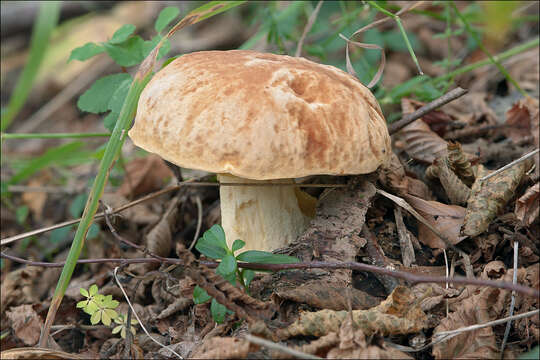Hemilecinum-depilatum_20

Description:
Hemileccinum depilatum (Redeuilh) utara, syn: Boletus depilatus Redeuilh, Leccinum depilatum (Redeuilh) utara, Xerocomus depilatus (Redeuilh) Manfr. Binder & Beslno name, DE: Gefleckthtigen Rhrling, Marmorierter Rhrling, Gehmmerter RhrlingSlo.: jamiasti gobanDat.: Sept. 22. 2016Lat.: 46.36172 Long.: 13.69608Code: Bot_1007/2016_DSC5049Habitat: light, young mixed wood and bushes, Ostrya carpinifolia dominant, some small, young Picea abies, a few very small (< 1 m tall) Fraxinus ornus, no Quercus and Carpinus in the vicinity; sparsely grass overgrown terrain in a mountain ravine; moderately inclined mountain slope, southeast aspect; base rich, colluvial, skeletal, calcareous ground, very shallow, soil layer on scree, sand and stones; half shade, relatively warm place; average precipitations ~ 3.000 mm/year, average temperature 5-7 deg C, elevation 745 m (2.440 feet), alpine phytogeographical region.Substratum: soil among stones under Ostrya carpinifolia canopies.Place: Lower Trenta valley, between villages Soa and Trenta, right bank of river Soa, close to the place where the trail to abandoned settlement Na Skalah passes the ravine Sraunk, East Julian Alps, Posoje, Slovenia EC. Comments: These yellowish appearing and not bruising boletes seem to be rather rare Hemileccinum depilatum. Typical traits of this find like curved, tapering or spindle-shaped stipe, fibrillose stipe surface, decidedly clear yellow pores when young, practically unchanging color of tubes, pores and flesh after exposure to the air, sometimes slowly reddening of the flesh above the tubes (see picture no.25), indistinctive taste, generally indistinctive smell except at base of stipe (unpleasant on chemicals) pileipellis with erect hyphae composed of inflated cells (as the most important distinguishing trait according to Ref.: 2), almost certain mycorrhizal relation with Ostrya carpinifolia (Ref.: 3) and obligatory calcareous ground, all fit well to the species description in literature. Description: Six pilei growing scattered, two growing together; pilei diameter from 5.5 to 17.5 cm, max tubes length 15-16 mm, context thick up to 22 mm; stipe length 7.5 to14 cm with 3 to 4.4 cm max diameter, usually tapering into a rooting base; smell almost absent or very mild, not unpleasant except in the base of the stems; taste mild, pleasant, a little bit mucous; flesh when cut not bruising; pilei surface and pore layer slightly sticking when touched (in dry weather). SP yellowish-ocher-brown, oac805.Spores smooth. Dimensions: 12 [13.6 ; 14.3] 15.8 x 4.1 [4.8 ; 5.2] 5.9 microns; Q = 2.4 [2.7 ; 2.9] 3.2; N = 32; C = 95%; Me = 13,9 x 5 microns; Qe = 2.8. Dimensions of subglobose or shortly cylindrical terminal cells of palisadoderm pileipellis hypha: 24 [34.3 ; 40.7] 51.1 x 11 [15.3 ; 17.9] 22.2 microns, Q = 1.3 [2.1 ; 2.6] 3.4; N = 18; C = 95%; Me = 37.,5 x 16.6 microns; Qe = 2.3. Olympus CH20, NEA 100x/1.25, magnification 1.000 x, oil (spores); NEA 40x/0.65, magnification 400x (pileipellis), fresh material, in water. AmScope MA500 digital camera.Herbarium: Mycotheca and lichen herbarium (LJU-Li) of Slovenian Forestry Institute, Vena pot 2, Ljubljana, Index Herbariorum LJFRef.:(1) Personal communication with Mr, Bojan Rot and Mr. Anton Poler.(2) P. Heinemann, J. Rammeloo, Two confused Boletes in the Benelux, Boletus impolitus Fries and Boletus depilatus Redeuilh, Persoonia (1992), Vol.14, pp 587-596; available at repository.naturalis.nl/document/569641 (3) Boris Assyov: boletales.com/genera/boletus/b-depilatus/ (4) G.J. Krieglsteiner (Hrsg.), Die Grosspilze Baden-Wrttembergs, Band 2, Ulmer (2000), p 228. (5) L. Hagar, Ottova Encyklopedia Hb, Ottova Nakladatelstvi, Praha (2015) (in Slovakian), p 525.(6) G. Kibby, British Boletes, Copyright Geoffrey Kibby (2011), p 17. (7) J. Breitenbach, F. Kraenzlin, Eds., Fungi of Switzerland, Vol.3. Verlag Mykologia (1991), p 52. (8) S. Buczacki, Collins Fungi Guide, Collins (2012), p 402. (9) tintling.com/pilzbuch/arten/b/Boletus_depilatus.html
Included On The Following Pages:
- Life (creatures)
- Cellular (cellular organisms)
- Eukaryota (eukaryotes)
- Opisthokonta (opisthokonts)
- Nucletmycea
- Fungi (mushrooms, lichens, molds, yeasts and relatives)
- Dikarya
- Basidiomycota (basidiomycete fungi)
- Agaricomycetes (Mushroom-Forming Fungi)
- Boletales
- Boletaceae (boletes)
- Hemileccinum
- Hemileccinum depilatum
This image is not featured in any collections.
Source Information
- license
- cc-by-nc-sa
- copyright
- Amadej Trnkoczy
- photographer
- Amadej Trnkoczy
- original
- original media file
- visit source
- partner site
- Flickr Group
- ID


